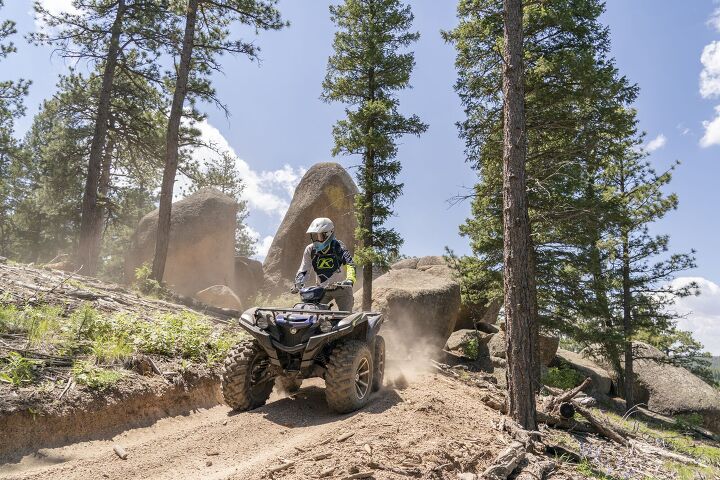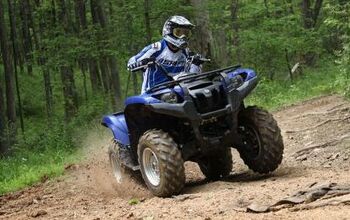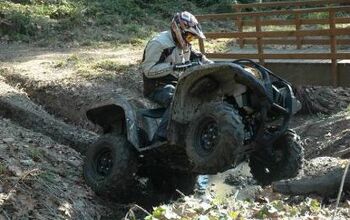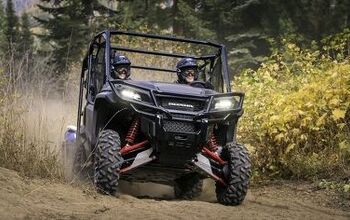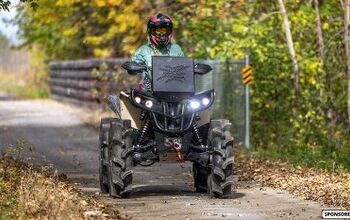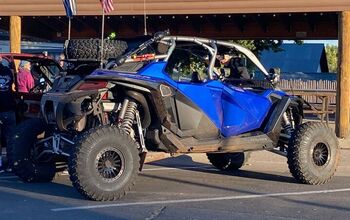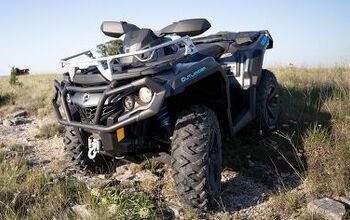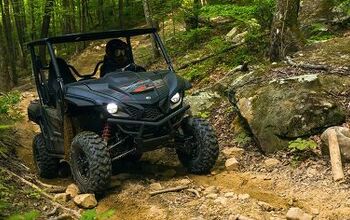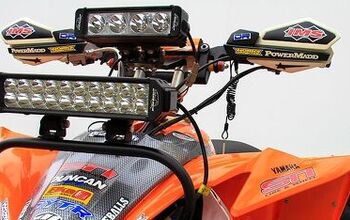Taming Yamaha’s Grizzly 700 In The Rockies
Even at 25 years old, the Yamaha Grizzly 700 is still the best-selling Utility ATV and we test it in the Colorado Rockies to see why.
It’s not uncommon to see ATV models come and go over the years as technology and consumer demands evolve, but when you’re doing things right some models are in it for the long haul. Such is the case with Yamaha’s formidable Grizzly 700. Even with 2023 being this model’s silver anniversary, not much has changed, and for good reason. You know the old adage “If it ain’t broke don’t fix it?” Well, that statement perfectly fits the Yamaha Grizzly 700.
Sure, over the years it’s seen its fair share of upgrades like electronic power steering, larger engine displacement, and the ever-popular bold new graphics, but in all reality, there haven’t been any jaw-dropping overhauls for the simple fact that it hasn’t needed it. Where other manufacturers have made the jump to 1000cc displacements for their Utility ATVs, Yamaha went from 660cc to a whopping 686cc. Why not go bigger? There wasn’t a need to.
To ensure that they are putting out machines that their customers want, Yamaha sends out surveys to get feedback from owners and what they found is that most Grizzly owners are happy with the machine as is. They didn’t need an extra 300cc’s to keep up with other big-bore Ute ATVS in races because that’s not what they’re being used for. Not to say that these can’t be raced, but most owners are using them for both work and play. Whether being used to haul hay, scout local hunting areas, or ride trails with friends, the Grizzly 700 seems to be perfect just the way it is.
It was found that consumers wanted a reliable ATV that could handle challenging terrain, had good gear storage capability, and provided a comfortable ride all day in the saddle. If you’ve ever ridden a Grizzly 700, you’d know that it checks all the boxes. Having suspension that can not only be comfortable handling loaded-down duties but still provide a sporty feel on the trail, the Grizzly 700 is a great all-around unit that is still extremely affordable compared to other models in its class.
One of the best features of this machine is the big-bore, single-cylinder 686cc engine. I know I’ve already talked about it a few different times above, but that’s how good it really is. The engine paired with Yamaha’s electronic fuel injection (EFI) system provides a perfect amount of power that is plentiful and useable across the powerband. It’s not a fast revving engine like you find in other big-bore ATVs but the big single produces an immense amount of torque that delivers when you want it. This doesn’t mean that the Grizzly 700 is a slouch. It still has plenty of get-up-and-go without feeling like your arms are going to be ripped off.
When you mate a solid powerplant to one of the most reliable drivetrains in the industry, you’ve got a proven winner. This starts with Yamaha’s tried and true Ultramatic CVT Transmission. Known to be the industry’s most durable CTV ever installed in an ATV, this transmission provides smooth power delivery to the wheels since it has been clutched primarily for recreational riding. Sure you can alter the clutching by changing rollers and spring weights with aftermarket clutch kits for increased torque under extreme conditions, what is set from the factory is adequate for the recreational rider or someone using this for work around a farm or ranch. Just to prove how much Yamaha believes in their product and setup, it offers an industry-exclusive 10-year belt warranty so long as regular maintenance is performed.
One of my favorite features of the Yamaha ATVs and SxS is their On-Command 4WD and Diff-Lock systems. There’s no guessing when 4WD might kick in, like other brands that engage with a certain amount of tire spin. When you want 4WD, all you need to do is press the button and in a matter of seconds, it’s engaged. The same goes for the diff-lock engagement. I just like the peace of mind of knowing that the wheels are turning when I want them to and not trying to guess when I should brace myself once the ATV finally finds traction.
I can go on and on about what propels this beast of an ATV, but I also need to discuss what brings it to a stop. The Grizzly 700 is equipped with a four-wheel hydraulic disc brake system that features separate handlebar-mounted front and rear brake controls, in addition to a floorboard-mounted rear brake pedal. Again, this is vastly different than some models that have braking systems all controlled off of a single lever. Having independent control of your front and rear brakes can improve the handling characteristics of the ATV. Even better is that this system can easily handle increases in tire size since the Grizzly 700 was also designed as a workhorse with a 1300 lbs. towing capacity.
It’s been a while since I’ve had the opportunity to throw a leg over the Grizzly 700, so when I was lucky enough to score an invite from Yamaha test one with some other media outlets at the Rampart Range OHV area in Colorado, I jumped at the chance. This OHV riding area provides 200 miles of trails that range from wide open to tight and technical, making it perfect for riders of every skill level.
When I threw a leg over Grizzly, it seemed like it was just yesterday that I had been on one of these ATVs. Everything about the controls felt familiar and the only thing that needed adjustment was the position of the brake levers, which is just a personal preference. With the push of a button, the big 686cc engine came to life and purred like a kitten. I had some concerns about how it would run since the elevation of this riding area varies from 6,500’ of elevation and could easily climb to over 8,500’ which could really affect the performance of a naturally aspirated engine. Not the case with the EFI system that manages the fuel for the Grizzly 700.
With a simple pull of the gate shifter, the transmission easily shifted into high range and followed our group through the trail gate. This is where I had to get used to something that I never really had to worry about when I lived and rode in the mountains of Southern California. Most of the trails there were fairly wide, but these trails were 50” wide and if you didn’t fit through the gate, you’d encounter some problems out on these trails. Even with the big GBC Grim Reaper tires installed on these units for this trip, the Grizzly squeezed through the gates with some room to spare. Normally the Grizzly 700 EPS SE and XT-R models, would be outfitted with 27” Maxxis Zilla tires that are great for muddy trail conditions, but in the dry conditions we’re riding in, the Grim Reaper tires were a better choice.
The first half hour or so, I felt myself riding conservatively as I was getting used to the tightness of the trails. We were riding on the trails that were carved into the hillsides that would occasionally squeeze between tall pine trees, in addition to large rocks and occasional boulders the size of small cars that would protrude from the side of the hills. For someone more used to riding on wide trails and open desert spaces, this was a drastic change. I will say that once I was able to find my groove and comfort level, I could start to appreciate the features of the Grizzly 700.
While the shocks aren’t fancy and only feature basic 5-position pre-load settings, they work well with the four-wheel independent suspension to provide a smooth ride over the varying terrain and trail obstacles. The wide-arc design of the a-arms provides ample ground clearance so having to worry about bashing the differentials or anything on the underside of the ATV was minimal.
I was very impressed by the power I had on tap. If you’ve ever ridden at high elevations, you can feel a loss of power from the lack of oxygen, but when on this machine at these high elevations it was rarely, if ever noticed at all. The 686cc engine never missed a beat or had a hiccup at any point of the day when out on the trail. Whether it be in low range navigating technical rock crawling sections or pushing the throttle wide open to climb the steep inclines, the power was smooth and on tap whenever you needed it. Simply put, the EFI system is on point when it comes to fuel delivery.
Now one of my favorite features that I have failed to mention thus far is the Electronic Power Steering (EPS) system. Just earlier this year, I was able to get some seat time in the Yamaha RMAX SxS, which was my first time in years. One of the features I liked best was their EPS system, which wasn’t available in the previous Yamaha SxS I had previously tested years before. I feel that their SxS EPS system is the best on the market after a few days on the rough trails. With a control unit that takes the input from speed and torque feedback, it delivers the perfect amount of electronic assist to make steering effortless.
This same system has been transferred to the Grizzly 700, which I can say was a lifesaver for more than just me on the trail that day. On more than one occasion, riders had clipped protruding rocks or tree roots that would have otherwise ripped the handlebars out of our hands, but because of the quick feedback that the EPS system received, it was able to compensate and assist in making the system act much like a steering dampener. After a long day of navigating the tight trails and hitting trail obstacles, our arms appreciated the help.
This was the same machine that I remember riding some time ago only better. Were there significant changes? No, but that’s the beauty of it. When you make a quality unit, you don’t necessarily have to make massive changes to make it rank the best in its class. All you need to do is keep following your winning formula and listen to what your customer base wants, which is exactly what Yamaha has done over the years. Even without having the opportunity to test the working capabilities of the Grizzly 700, I have no doubt that It would prove itself as a useful tool on a farm or ranch as it has proven itself on the trails.
More by Eli Madero



